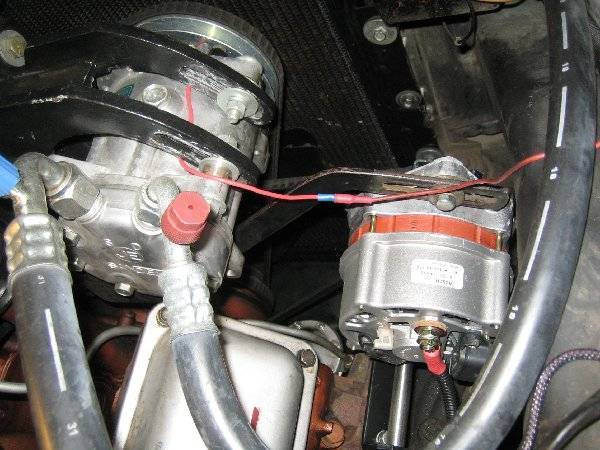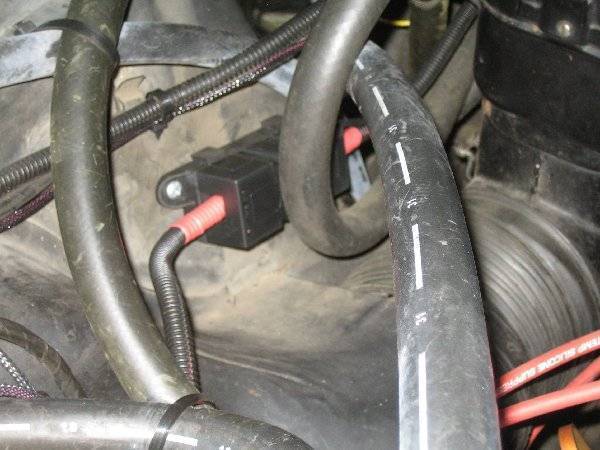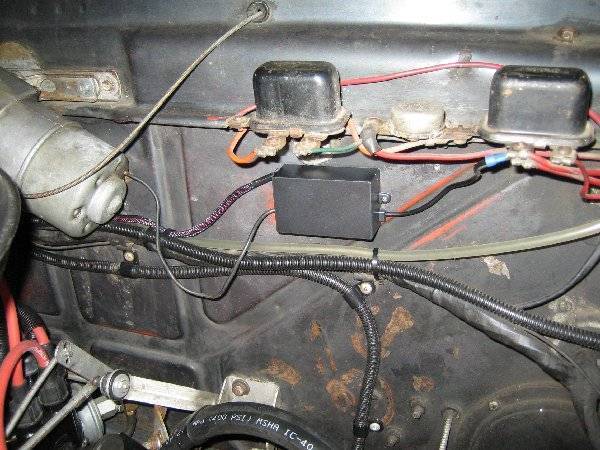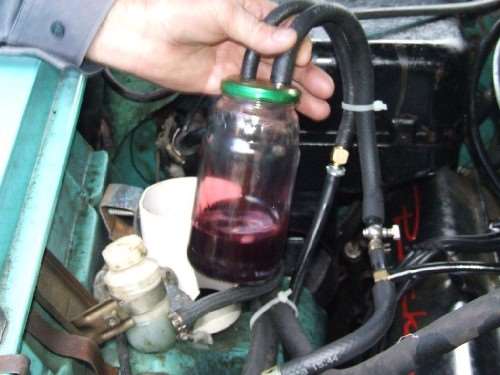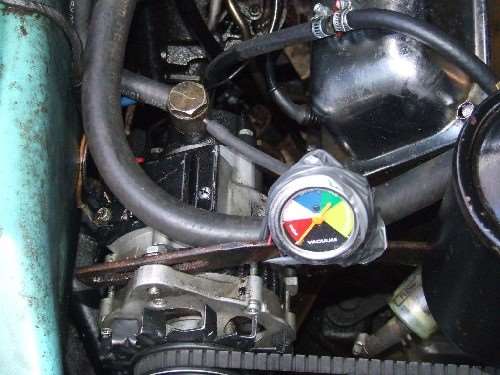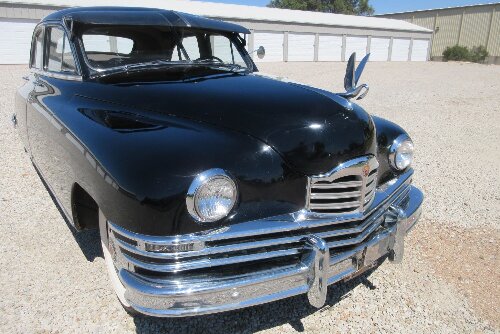|
Re: Alternator & Ammeter
|
||||
|---|---|---|---|---|
|
Webmaster
|
Is the AMP Meter wired inline between the BATT terminal on the ALT and the junction to the main harness? Nothing else should be wired between the BATT terminal and the AMP meter.
Posted on: 2016/6/9 12:54
|
|||
|
-BigKev
1954 Packard Clipper Deluxe Touring Sedan -> Registry | Project Blog 1937 Packard 115-C Convertible Coupe -> Registry | Project Blog |
||||
|
||||
|
Re: Alternator & Ammeter
|
||||
|---|---|---|---|---|
|
Forum Ambassador
|
Going along with what Kev just said this has been an issue before and no satisfactory answer yet. Some have tempted fate and kept the small ga wire for the alternator and others replaced the wire similar to your approach but live with the ammeter. If you didn't want to see a constant discharge you could also place a heavy jumper across the ammeter terminals so it always registers 0 and then use your light output signal to place an idiot light under the dash -- instant Clipper.
Referring to the 56 diagram and wires labeled #1 and #2. Normally the generator output is connected to the battery via the ARM or GEN terminal on the regulator and contacts in the regulator connect it to the #2 wire on the BAT terminal. That way the output goes thru the ammeter first and then on to battery via the #1 wire which connects to the battery at the solenoid. With your alternator directly connected to the battery at the solenoid same place as the #1 wire you are completely bypassing the ammeter. The #2 wire is supplying almost everything in the car so if there is no charging coming into that side all the ammeter sees is the discharge. If the generator has output, then that being applied to the #2 wire in addition to any coming directly from the battery thru the ammeter lets the ammeter see what is happening -- either registering charge when the generator is keeping up with the draw plus delivering enough to the battery to keep it charged or a discharge if not. With your connection, even if the alternator is charging the ammeter can't see it. With the direct reading ammeter in our cars it is going to be extremely difficult to have the output pass thru the ammeter safely. Even if you could replace the 10 or 12ga wire that is there now with recommended 6ga the ammeter is undoubtedly not capable of carrying 85 amps. It would be so much easier if the ammeter was actually a voltmeter calibrated in amps and fed via the voltage developed off a shunt resistor. You could just extend the wires and relocate the shunt resistor with a heavier one for the 85 amps if that were the case. I don't know the internal construction of our ammeters. It is possible there is a small shunt inside that could be made external and larger but I doubt it. Maybe there is something an instrument place could do but I expect the cost would be considerable.
Posted on: 2016/6/9 13:45
|
|||
|
Howard
|
||||
|
||||
|
Re: Alternator & Ammeter
|
||||
|---|---|---|---|---|
|
Home away from home

|
Folks,
On my 47 2106 the owners manual says the "ammeter" is not one! Is it a voltage meter, then_?
Posted on: 2016/6/9 14:23
|
|||
|
||||
|
Re: Alternator & Ammeter
|
||||
|---|---|---|---|---|
|
Forum Ambassador
|
Good question. Since all the current in the car (except for the starter motor) goes thru the gauge I am thinking it functions the same way an ammeter does. Packard may have chosen to refer to it as a charge indicator as a CYA because there is no scale and the needle swing may not be linear or proportional to actual current.
Interesting the 47 labels the gauge BATTERY, no indication on the 48-50 gauges, the 55 has it labeled AMP and the 56 calls it GEN. Parts book calls it an ammeter.
Posted on: 2016/6/9 14:44
|
|||
|
Howard
|
||||
|
||||
|
Re: Alternator & Ammeter
|
||||
|---|---|---|---|---|
|
Home away from home
|
Hello all, i wanted to use my vacuum wipers so I fitted a diesel alternator with a vacuum pump on the end. I wired it to the Batt position on the regulator so it shows charge discharge on the ammeter. I also used some of the vacuum to draw oil from under the bell housing into a bottle. This is six months worth. The alternator fitted where the generator was with the same brackets and drive belt. It works well. PT
Posted on: 2016/6/9 17:41
|
|||
|
I like people, Packards and old motorbikes
|
||||
|
||||
|
Re: Alternator & Ammeter
|
||||
|---|---|---|---|---|
|
Home away from home

|
Thanks Gents, your input is much appreciated. I initially thought that with my wiring, the alternator current would bypass the ammeter and it then wouldn't register anything. However, when it did show a discharge I started to get concerned that I might end up frying something so thought I should ask about what I could do to either fix it or disconnect it completely. Howard's comments that the discharge causing the needle to move is not directly related to the alternator charge in itself and is therefore not a major concern, providing I could live with the needle deflection, is a great relief.
Yes, I could live with it. Also, today I tried to reach it to see about perhaps disconnecting the wires. However, being a 71 year old who is not as supple as I used to be, I can't even see the confounded meter, let alone reach it. I might go and see an auto elec and get his advice about the best way to proceed. In the meantime, I've bought a digital voltmeter that is designed to plug into the cigarette lighter socket and I can see whether the alternator is charging, or not, and the charge voltage (it's been pretty accurate thus far). When leaving the car I just unplug the meter, put it in the glovebox and replace it with the lighter. Thanks once again fellas. John
Posted on: 2016/6/10 0:27
|
|||
|
||||
|
Re: Alternator & Ammeter
|
||||
|---|---|---|---|---|
|
Home away from home
|
Hello John, I am not sure why you haven't just attached the alternator output to the Batt connection on the original voltage regulator. This would enable your meter to centralise with input and output currents. You have effectively bypassed the charge/discharge meter ( hasn't been an Ammeter on Packards since 1937) There is always a concern with an 85 amp alternator and the wiring rating of your Patrician but that would be the case no matter where you connected it to in a 1956 wiring loom. You would certainly smell the "ammeter" if 85 amps was passing through it.
I don't know how to post the links to previous threads but I detailed all of the fitment of the alternator on the 12th May 2010. There was lots of interest in it and it has given no problems whatsoever and the Charge discharge meter works brilliantly. Best Regards Peter T
Posted on: 2016/6/10 2:59
|
|||
|
I like people, Packards and old motorbikes
|
||||
|
||||
|
Re: Alternator & Ammeter
|
||||
|---|---|---|---|---|
|
Forum Ambassador
|
Posted on: 2016/6/10 3:44
|
|||
|
Mal
/o[]o\ ====  Bowral, Southern Highlands of NSW, Australia "Out of chaos comes order" - Nietzsche. 1938 Eight Touring Sedan - SOLD 1941 One-Twenty Club Coupe - SOLD 1948 Super Eight Limo, chassis RHD - SOLD 1950 Eight Touring Sedan - SOLD What's this?  Put your Packard in the Packard Vehicle Registry! Here's how! Any questions - PM or email me at ozstatman@gmail.com |
||||
|
||||
|
Re: Alternator & Ammeter
|
||||
|---|---|---|---|---|
|
Home away from home
|
Thanks Mal, You're a whizz at this game. I have since replaced the converter O ring seal and it does not leak trans fluid. It does however weep engine oil from the rear main since I changed to the Olds hi-flow oil pump. About 50 mils per 12 months. The huge blessing with the alternator is that the battery charges at low RPM, unlike the generator system which requires the regulator points to close before charging. it is fabulous for low speed cruising. PT
Posted on: 2016/6/10 3:56
|
|||
|
I like people, Packards and old motorbikes
|
||||
|
||||

 (299.99 KB)
(299.99 KB)